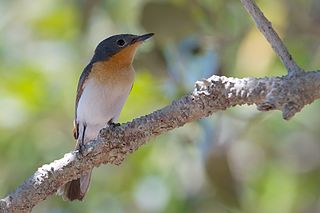
The red-breasted goose is a brightly marked species of goose in the genus Branta from Eurasia. It is currently classified as vulnerable by the IUCN.

The little grebe, also known as dabchick, is a member of the grebe family of water birds. The genus name is from Ancient Greek takhus "fast" and bapto "to sink under". The specific ruficollis is from Latin rufus "red" and Modern Latin -collis, "-necked", itself derived from Latin collum "neck".

The brown-necked raven is a larger bird than the carrion crow though not as large as the common raven. It has similar proportions to the common raven but the bill is not so large or deep and the wings tend to be a little more pointed in profile. The head and throat are a distinct brownish-black giving the bird its English name, while the rest of the plumage is black glossed with purple, blue or purplish-blue. Like the common raven, thick-billed raven and white-necked raven, it is one of the larger raven species. The feathers of this species often fade quite quickly to a brownish black and the bird can look distinctly brown by the time it moults. The feet, legs and bill are black. The dwarf raven was formerly considered a subspecies but this bird now appears to be closer to the pied crow than this species.

The red-necked stint is a small migratory wader. The genus name is from Ancient Greek kalidris or skalidris, a term used by Aristotle for some grey-coloured waterside birds. The specific ruficollis is from Latin rufus, "red" and collum, "neck".

The southern rough-winged swallow is a small swallow. It was first formally described as Hirundo ruficollis by French ornithologist Louis Vieillot in 1817 in his Nouveau Dictionnaire d'Histoire Naturelle.

The broad-billed flycatcher is a species of bird in the family Monarchidae. It is found in northern Australia, the Lesser Sunda Islands and southern New Guinea. Its natural habitats are subtropical or tropical moist lowland forest, subtropical or tropical mangrove forest, and subtropical or tropical moist montane forest.

Phytoecia is a genus of longhorn beetles of the subfamily Lamiinae,
Phytoecia gianassoi is a species of beetle in the family Cerambycidae. It was described by Sama in 2007 and later reclassified to the subgenus Coptosia within the genus Phytoecia.
Phytoecia aterrima is a species of beetle in the family Cerambycidae. It was described by Stephan von Breuning in 1951. It is known from the Democratic Republic of the Congo and Zambia. It contains the varietas Phytoecia aterrima var. gilbertae.
Phytoecia atricollis is a species of beetle in the family Cerambycidae. It was described by Stephan von Breuning in 1954. It is known from the Democratic Republic of the Congo and Tanzania.
Phytoecia pseudolateralis is a species of beetle in the family Cerambycidae. It was described by Stephan von Breuning in 1954. It is known from the Democratic Republic of the Congo.
Phytoecia basilevskyi is a species of beetle in the family Cerambycidae. It was described by Stephan von Breuning in 1950. It is known from the Democratic Republic of the Congo.
Phytoecia neavei is a species of beetle in the family Cerambycidae. It was described by Per Olof Christopher Aurivillius in 1914. It is known from the Democratic Republic of the Congo.

Phytoecia puncticollis is a species of beetle in the family Cerambycidae. It was described by Faldermann in 1837. It is known from Russia, Azerbaijan, Georgia, Iraq, Armenia, Turkey, Iran, and Turkmenistan. It feeds on Eryngium billardierei.

Phytoecia scutellata is a species of beetle in the family Cerambycidae. It was described by Johan Christian Fabricius in 1793, originally under the genus Saperda. It has a wide distribution in Europe, although its populations in Germany and the Czech Republic are reportedly extinct. It measures between 7 and 14 mm.

Phytoecia caerulescens is a species of beetle in the family Cerambycidae. It was described by Scopoli in 1763, originally under the genus Leptura. It has a wide distribution in Europe, and has been introduced into Australia. It feeds on Echium vulgare, Lappula squarrosa, Anchusa officinalis, Lithospermum officinale, and Cynoglossum officinale.
Phytoecia molybdaena is a species of beetle in the family Cerambycidae. It was described by Dalman in 1817. It has a wide distribution in Europe; its population in the Czech Republic is purportedly extinct. It measures between 5 and 7 mm.

Phytoecia caerulea is a species of beetle in the family Cerambycidae. It was described by Scopoli in 1772, originally under the genus Leptura. It has a wide distribution in Europe.
Phytoecia cylindricollis is a species of beetle in the family Cerambycidae. It was described by Hermann Julius Kolbe in 1893, originally under the genus Blepisanis. It is known from the Ivory Coast, the Democratic Republic of the Congo, Ghana, Guinea, Benin, Gabon, and Togo.
Phytoecia sylvatica is a species of beetle in the family Cerambycidae. It was described by Hintz in 1916, originally under the genus Obereopsis. It is known from the Democratic Republic of the Congo. It contains varietas Phytoecia sylvatica var. atroapicalis.










